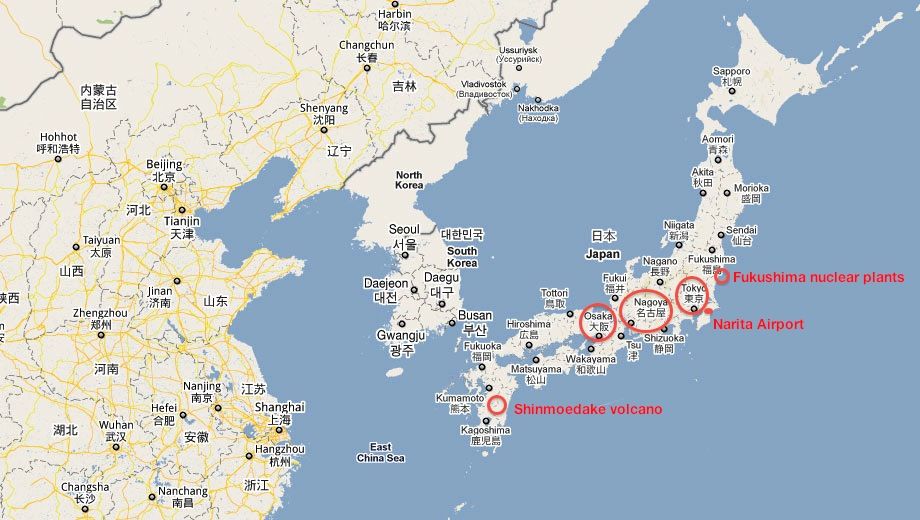Is it safe to travel to Japan? Danger areas plotted on a map

Australian Business Traveller has plotted the areas of disruption and potential danger in Japan following last week's earthquake, tsunami and now nuclear crisis, plus the ash cloud coming from Shinmoedake volcano.
We've also included the location of key diversion airports, so business travellers considering travel to the region (against current DFAT Smartraveller advice) can make an informed decision about their trip.
Damage from Friday's earthquake and tsunami is spread over nearly a thousand kilometres of eastern and northeastern Japan, while extensive delays, diversions and cancellations at Tokyo's main Narita and Haneda airports.
Two hundred kilometres to the northeast, the Fukushima nuclear power stations are experiencing major problems, while the Shinmoedake volcano is also erupting 1000 kilometres away to the southwest, throwing an ash cloud into a main air route.
Tokyo, Narita and Haneda Airports
Tokyo is one of the largest cities in the world, and Japan's capital. It surrounds Tokyo Bay, with the main part of the city to the northwest of the bay.
Damage to the Tokyo region has been relatively minor, the result of robust building codes and reinforced structures. However, with a significant number of the country's nuclear power stations offline due to damage or for safety checks, rolling power outages are in place across the capital region.
Transport is also significantly disrupted, with airport express, regional, intercity and Shinkansen bullet trains running on sharply reduced timetables to conserve power. Subways and metro services are also highly limited.
Narita Airport (NRT) is 60 km to the east of central Tokyo in Chiba Prefecture, and handles the majority of international flights, including all flights to Australia. Trains are running to Narita, including the Narita Express high-speed line, though on a reduced schedule. Road traffic to the airport is very heavy as a result, though the airport is "gradually returning to normal" according to a spokesperson.
Haneda Airport (HND) is 15 km to the south of central Tokyo, and sits at the edge of Tokyo Bay. Haneda is older and smaller than Narita, and has recently expanded to allow international flights. Trains to and from Haneda are running, but less frequently than normal.
Fukushima and the nuclear power crisis
The Fukushima nuclear power plants (Fukushima Daiichi and Daini, which translates to Fukushima I and II) are on the east coast of Japan, some 45 km southeast of Fukushima city itself.
Central Tokyo and Haneda Airport lie some 250 km to the south-southwest of the plants. Narita Airport is closer: the plants are roughly 210 km north of Narita Airport.
Australian government advice is to avoid the area and surrounding prefectures, and to follow the directions of Japanese authorities in the event of a radiation emergency.
Osaka and Nagoya, diversion airports for Tokyo
With Tokyo Narita disrupted, many flights are being diverted to alternate airports, particularly Osaka Kansai and Nagoya Chubu Centrair.
Osaka is roughly 500 km to the west of Tokyo. Its Kansai International Airport (KIX) is on an artificial island in the Osaka Bay and is serving as one of the principal diversion airports for flights that would normally go to Tokyo.
Nagoya, where Chubu Centrair International Airport is also receiving many international flights diverted from Tokyo airports, is between Tokyo and Osaka: just over 325 km west of Tokyo, and 175 east of Osaka.
Shinmoedake volcano and ash cloud
Shinmoedake, the volcano currently causing concerns for international flight diversions, is in the far southwest of Japan, on the island of Kyushu, over 1000 km west-southwest of Tokyo. (map)
The volcano -- and its ash cloud -- is actually closer to Shanghai and Seoul than it is to Tokyo, which is why airlines and business travellers are watching carefully. On the ground, evacuation orders are in place.
An ash plume from the volcano could ascend to a height hazardous to aircraft, which would mean a potential shutdown of airspace similar to the closure of a sizeable part of Western Europe after Iceland's Eyjafjallajökull volcano erupted last year.
This airspace is also used by flights from hubs in southeast Asia and southern China to the west coast of the US and Canada. So flights from Hong Kong, Bangkok, Singapore and other airports flying to Western US cities like Los Angeles, San Francisco, Seattle and Vancouver could have to divert around the ash cloud.
While very few Australian travellers would choose to reach North America via Asia, the knock-on effects of aircraft out of place could well affect flights from the Asian hubs to and from Australia.
Australians travelling to Japan via Asian hubs could also be affected.

Hi Guest, join in the discussion on Is it safe to travel to Japan? Danger areas plotted on a map